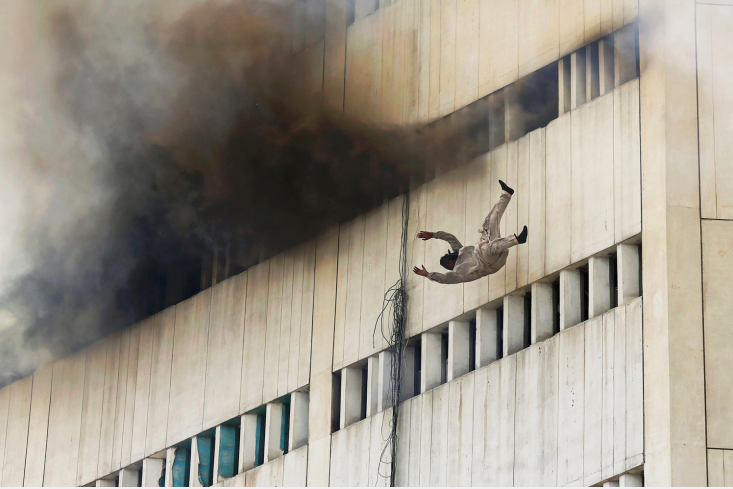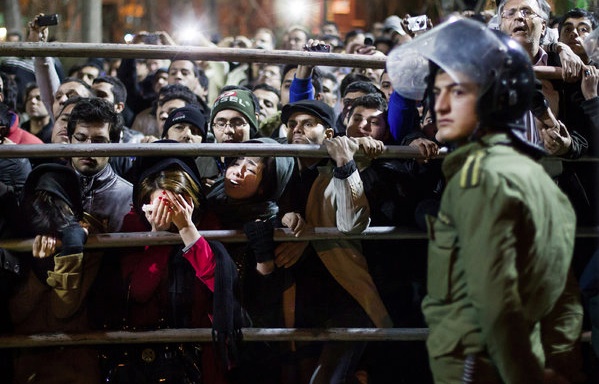The man we see here is in the clutches of death. Still alive, but only for a few seconds before his body meets with the pavement five floors below, his death is imminent and all but certain. As Barbie Zelizer points out, such “about to die” images sanitize the visual representation of death, emphasizing the contingency of the moment while nevertheless gesturing to the only logical conclusion. Such images not only neutralize the emotional affect and spectacle of a broken and mutilated body, but they serve as well to draw the viewer into the scene, inviting contemplation of the subjunctive moment and to consider the possibilities inherent in the image (if not in history itself). Photographs of death have a finality to them that the visual trope of an “about to die” photograph challenges. And because the still image stops the action for all time it leaves open—for all time—the tentative possibility of alternate outcomes.
The photograph above is of a man who has “fallen” from a burning building in Lahore, Pakistan. Or at least that is how the caption for the image typically reads. It is more likely that he jumped to his death—as did at least four others—to avoid the immolation that killed at least seventeen people. But whether he jumped or fell, it is clearly an “about to die” image. It was reproduced in many of the “pictures of the day/week” slideshows that are now featured at most journalistic websites. What drew my attention to it, however, had less to do with the simple fact of its quality of an “about to die” image and more with how it reprises similar images of people plunging to their deaths from Manhattan’s Twin Towers on 9/11.
There is no official count of how many people jumped from the towering infernos on that fateful day, but the lower end estimations put the number at nearly 200. Many of the jumpers were captured by videographers and a number of still photographs appeared in newspapers, though almost never on the front page. More importantly, these photographs disappeared from public view almost as quickly as they had originally appeared, virtually erased from the public record through at least the tenth anniversary of the event itself. One can now access some of these photographs by searching on the internet, but the larger question has to be why it was deemed inappropriate to broadcast and publish such images then, and yet now it seems acceptable to document the tragic fire in Lahore with virtually identical images and, indeed, to feature the photograph in institutionally sanctioned journalistic websites?
One answer to this question is the assumption that foreign lives count for less than American lives; it is hard to abide such cynicism, but events in recent years make it an answer that we should not discount altogether. Nevertheless, I think there is something more going on here than an hyperbolic and over-extended American exceptionalism. One of the features of the “about to die” photograph is that it activates an audience engagement with the image that bridges the distance between here and there, implicating the viewer in the scene being depicted by requiring them to complete the event frozen in time, both cognitively and affectively. This can produce an especially powerful identification when the actors portrayed are strangers, distant others, as we would imagine most Pakistani citizens to be for most American viewers. When the actors are easily identified with—by type if not as particular individuals—the problem is reversed, as there is an emotional need to provide some measure of distance. In the immediacy and aftermath of 9/11 the problem of distance from those who died in the terrorist attack had to be managed differently as the photographs operated in an interpretive register that distinguished social identity (which arguably needed to be pushed to the background so as to mute social pain) from political identity (which needed to be placed in the foreground to animate the anger needed to spur collective action).
The point is a simple one, but worth emphasizing: as with linguistic conventions, so with the conventions of visual representation, literacy dictates attention to context at multiple levels: historical, social, cultural, political, and so on. And perhaps most important in recent times, international and global. And more, it is in learning how to interpret and engage with such images that we begin to get a sense for what it means to see and be seen as citizens in all of these different registers.
Photo Credit: Damir Sagolj/Reuters


